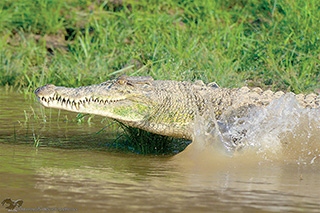Sabah croc population stable
Published on: Friday, August 24, 2018

Kota Kinabalu: There is a stable crocodile density in Sabah, said the Danau Girang Field Centre (DGFC)."The last population survey on crocodiles was done by the Sabah Wildlife Department (SWD) in 2002, indicating a density of 2.27 crocodiles per kilometre of river," said DGFC, in a statement, Thursday. "And the recent one-year survey conducted in 2017 yielded a crocodile density of 2.29 per kilometre of river.
ADVERTISEMENT
"However, given that this is a single sampling event, further ongoing surveys are required to determine the true trend in population numbers. "The actual population figures and trend can only be determined at the end of the three-year survey, which will be completed in 2019," it added.In 2017, DGFC was appointed by SWD to conduct a three-year State-wide population assessment on Sabah's saltwater crocodile population with an aim to provide a more complete understanding of the current distribution, and relative densities of the species, following a purported rise in Human Crocodile Conflicts (HCC). This research covers 10 of the largest river systems in Sabah. The first-year assessment was completed in November 2017 and the second-year assessment is ongoing.
ADVERTISEMENT
DGFC said this in response to some of the questions posed by the group "Concerned Conservationist", which was published in Sunday Forum on Aug 12, regarding the public auction of two saltwater crocodiles, which was eventually called off.DGFC was also unaware of any evidence of an unprecedented rise in numbers, anywhere in the State.
ADVERTISEMENT
"At best, the last 15 years have seen a stabilisation of numbers, but despite this, some rivers appear to have seen a decrease in overall numbers. "Once again, this must be caveated with the fact that further surveys will shed additional light on this topic. "DGFC is not aware of such an escape of crocodiles from an allegedly illegal crocodile farm situated in Penampang. "What we do know is that there is a crocodile farm in Kampung Kibambangan next to the Petagas River that has had concerns raised for its poor management and lack of safety measures," it said.It added that the crocodiles there are kept in extremely poor and unsanitary conditions and we have alerted the SWD and the Tourism, Culture and Environment Ministry."Whether or not the population of wild crocodiles has increased, DGFC is not aware of a policy. "As such, that allows public auctions of live, wild crocodiles for public consumption in Sabah (as per the Wildlife Conservation Enactment 1997)."However, given the species' status as Schedule 2 protected, this appears to fall outside of the remit of the Wildlife Enactment. "If the SWD has conducted these activities in the past, DGFC has not been aware of them. "In this particular case, DGFC was not requested to provide advice or assistance," it said. It also said that licensed crocodile farms within the State are, however, permitted to sell crocodiles for meat or leather.DGFC reminded the public that they are not permitted to hunt crocodiles, collect eggs or remove them from the wild under any circumstance as they are listed as Schedule 2 species in Sabah."Given this status, SWD is legally committed to protect crocodiles from general public hunting, under the terms of the 1997 Wildlife Enactment."Meanwhile, DGFC said it is possible to translocate captured crocodiles into rivers that are more isolated from people. "The results of the first-year of survey and the preliminary results of the second-year (70 per cent complete) indicate there are rivers with very low crocodile density and human settlement. "Such rivers could be ideal locations to release problematic crocodiles," it said. However, it added, the carrying capacity of the river – the quantity and quality of available prey – must also be taken into consideration. Regarding the fitting of satellite tracking devices, their deployment is subject to several caveats. "Firstly, the animal must meet a minimum weight requirement to be able to bear the weight of the device. Stay up-to-date by following Daily Express’s Telegram channel.
Daily Express Malaysia




